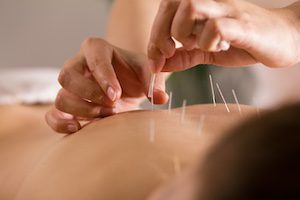Acupuncture vs Dry Needling

Acupuncture vs Dry Needling
Your Path to Pain Relief and Recovery

Introduction
Acupuncture and dry needling are popular techniques for pain relief and rehabilitation. While both involve needles, their approaches and philosophies differ. This article will explain these differences, backed by recent research, and guide you on when to consider each treatment.
Acupuncture: A Time-Tested Method for Balance and Healing
Acupuncture, a cornerstone of Chinese medicine, dates back thousands of years. It’s based on the belief that illnesses arise from imbalances in the body’s energy, known as Qi. This energy flows through channels and meridians, and its free flow is crucial for natural balance and health. By inserting needles into specific points along these meridians, acupuncture aims to restore balance and promote healing.
Dry Needling: A Modern Approach to Muscle Pain and Myofascial Dysfunction
Developed by Dr Chan Gunn, dry needling, also known as intramuscular stimulation (IMS), targets muscular pain and myofascial dysfunction. Unlike acupuncture, dry needling involves inserting needles into muscle trigger points without injecting any substance. It’s based on Western anatomical and neurophysiological principles. The goal is to release muscle tension, reduce pain, and improve function.
What is the Difference Between Acupuncture and Dry Needling?
Acupuncture and dry needling differ in their underlying principles and applications. Acupuncture is rooted in traditional Chinese medicine and focuses on balancing the body’s energy (Qi) by stimulating specific points along meridians. In contrast, dry needling is based on Western medical principles and targets muscle trigger points to alleviate pain and improve function. While both techniques use thin needles, acupuncture aims to balance energy, whereas dry needling focuses on treating musculoskeletal issues.
When to Consider Acupuncture or Dry Needling
Both treatments can be effective for a variety of conditions, including:
- Back Pain
- Neck Pain
- Shoulder Pain
- Elbow Pain
- Hip Pain
- Knee Pain
- Calf Pain
- Sciatica
- Headaches
- Muscle Injuries
- Joint Pain
Physiotherapists often recommend these treatments after a thorough assessment of your condition.
The Science Behind the Techniques
Recent studies highlight the effectiveness of both acupuncture and dry needling in managing pain and aiding rehabilitation. For instance, a 2023 study found that dry needling significantly reduced muscle pain and improved mobility in patients with chronic conditions. Another study showed that acupuncture can effectively reduce chronic pain and improve overall well-being by balancing the body’s energy.
What to Do? Seeking Professional Advice
If you experience any of the above conditions, consulting a physiotherapist or doctor is the first step towards recovery. They can assess your condition and recommend the most suitable treatment approach, whether it be acupuncture, dry needling, or a combination of both. Physiotherapists trained in these techniques can tailor a treatment plan specific to your needs.
Conclusion
Acupuncture and dry needling offer a blend of ancient wisdom and modern science for pain relief and injury rehabilitation. Always seek advice from a qualified physiotherapist or healthcare practitioner trained in these techniques to determine the best treatment option for you.
Rochedale - Call 38410277
Book Online: RochedaleSalisbury - Call 32751044
Book Online: SalisburySandgate - Call 32691122
Book Online: SandgateDry Needling & Acupuncture FAQs
1. What is dry needling? Dry needling involves inserting thin needles into muscle trigger points to alleviate pain and improve function. It targets myofascial pain and dysfunction.
2. How does acupuncture work? Acupuncture involves inserting needles into specific points on the body to balance energy flow (Qi) and promote healing. It’s a key component of traditional Chinese medicine.
3. Is dry needling the same as acupuncture? No, dry needling and acupuncture use different principles. Dry needling is based on Western anatomical and neurophysiological principles, while acupuncture is rooted in traditional Chinese medicine.
4. What conditions can dry needling treat? Dry needling can treat various musculoskeletal issues, including back pain, neck pain, shoulder pain, and headaches.
5. Can acupuncture help with chronic pain? Yes, acupuncture can be effective in managing chronic pain by restoring the body’s energy balance and promoting natural healing processes.
6. Should I consult a physiotherapist before trying these treatments? Absolutely. A physiotherapist can assess your condition and recommend whether acupuncture, dry needling, or another treatment is best suited for you.
Related Articles
- Dry Needling for Muscle Pain Discover how dry needling can help alleviate muscle pain and improve function.
- Acupuncture: Traditional Techniques for Modern Healing Learn about the benefits of acupuncture in modern pain management and recovery.
- Physiotherapy for Back Pain Explore effective physiotherapy treatments for back pain relief.
- Neck Pain: Causes and Treatments Understand the common causes of neck pain and the best treatment options.
- Shoulder Pain: Physiotherapy Solutions Find out how physiotherapy can address shoulder pain and improve mobility.
- Elbow Pain: Effective Physiotherapy Treatments Discover physiotherapy techniques that can help relieve elbow pain.
- Hip Pain: Causes and Physiotherapy Treatments Learn about the causes of hip pain and how physiotherapy can help.
- Knee Pain: Physiotherapy and Recovery Understand how physiotherapy can assist in knee pain recovery.
- Sciatica: Relief and Rehabilitation Explore physiotherapy methods for managing and recovering from sciatica.
- Headache Relief with Physiotherapy Find out how physiotherapy can help alleviate headaches.
- The Science Behind Acupuncture Learn about the scientific evidence supporting the use of acupuncture for various conditions.















































